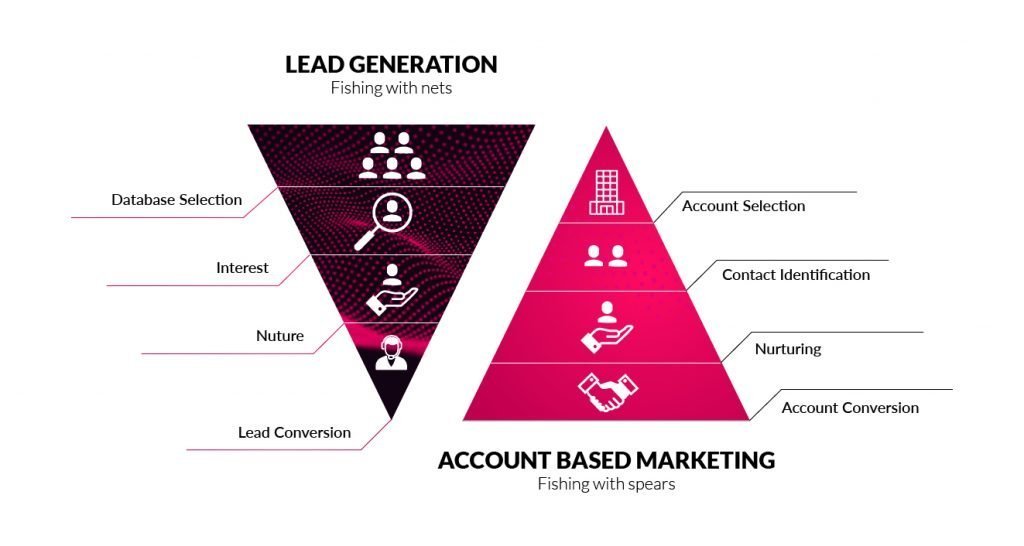Account based marketing is a relatively new marketing concept, especially when comparing it to the approach of traditional marketing.
Every interaction with a customer/prospect is contributing to developing the relationship – and the best way to do this is to ensure they feel valued from the outset. Show them that you are addressing their needs. Many marketing campaigns can consist of a “throw it at the wall and see what sticks” approach. In other words, creating and distributing as much content as possible through as many channels as possible to try and maximise the number of leads you get. The problem with this is that the “leads” you are acquiring may not be the prospects your company needs and, in the end, you have wasted time and resources on leads that will never convert.
This is where an Account Based Marketing (ABM) approach can benefit your organisation.
What is Account Based Marketing?
In its simplest form Account Based Marketing is essentially a strategy used in B2B marketing to identify and engage a specific set of target accounts. It requires both the marketing and sales teams to work closely together to identify these target accounts and identify how to convert them. It’s a strategy based completely around identifying the most valuable accounts and targeting those accounts with specific, personalised campaigns. It has growing massively in popularity with 92% of B2B marketers considering it “extremely” or “very” important to their marketing efforts
Additionally according to ITSMA Research, 87 % of marketers implementing ABM say that it delivers higher ROI than any other type of marketing. In the same report a majority of their respondents reported an improvement in the three R’s of strategic marketing with 84% reporting improvement in Reputation (Brand Perception, awareness and knowledge), 74% reporting improvement in Relationships (Number of Relationships Across accounts), and 69% reporting improvement in Revenue.
Account Based Marketing V’s Traditional Marketing
Fishing with Nets v Fishing with Spears
The ABM approach flips the traditional marketing funnel completely – Instead of ending with your target list of accounts, as is the case with traditional inbound marketing activities; With an ABM approach, you start with your high value target accounts who you have identified as being the biggest opportunities and focus your activities and tailor your marketing to them.

In traditional lead generation, marketing teams cast their net far and wide in the hope of pulling in as many leads as possible for the sales team to follow up on and whittle down even further until hopefully there are a few conversions. A lot of time and budget are spent trying to catch the ‘right fish’.
ABM is like fishing with a spear and takes the opposite approach. Instead of ending a campaign with an assortment of potential prospects, you start it already knowing who your high value accounts are and aim to “catch” these first. Why? These accounts are far more likely to convert and so offer a far better source of potential revenue.
A quote attributed to David Oglivy (often referred to as the “Father of Advertising”) probably helps sum this up in another way “Dont count the people you reach, reach the people that count”. Although he wasn’t referring to Account Based Marketing Programs, it is absolutely relevant in this sense also.
Now that we understand what defines an ABM approach let’s take a look through some of the types of ABM programmes you can implement.
The 3 types of ABM
There is generally a consensus that there are three types of ABM you can implement as part of your strategy
- One to One
- One to Few
- One to Many
One-to-One ABM


One-to-Few ABM


One-to-Many


How do you implement ABM strategy?
Step 1
Team Alignment
Step 1 in an ABM approach is getting your team aligned. There is no “I” in ABM. In order to give your program the absolute best chance of success you need organisational alignment, specifically alignment between sales and marketing. Traditionally, marketing have generally operated at the top of the funnel, providing as many leads as possible, and then sales would come in and operate that account. With an ABM approach, the goal is to get marketing adding value throughout the funnel until a deal is closed and not just at the top. You want both teams involved from the outset in setting expectations, outline KPI’s, sharing knowledge etc.
Step 2
Identify & Research Target Accounts
A clear picture of who your ideal customer is, is the backdrop of an ABM approach. Your target accounts should be the companies from your most successful segments most likely to buy from you. So, as a starting point look at your existing customer database to gain info on the characteristics of your largest accounts – things like company size, industry they operate in, geographical location etc. Then look at aspects such as common pain points they share, what / who drives their purchasing decisions, what is their typical customer journey etc. Customer Surveys may be an ideal way to get really detailed data that your CRM system may not be providing.
A key part of this research also is to identify who the key decision makers are in you target account list. This is where the collaboration between sales and marketing identified in the previous step comes in handy. The sales team will have far more detailed knowledge on the key decision makers within companies they have dealt with previously so can provide marketing with great insights on who to target within the target account list.
Once you have all this data, it is time to move onto the next step.
Step 3
Create Relevant Content
Once you have finalised your target account list, it’s time to move on to the next step…Relevant Content! And whats the most engaging content for B2B buyers? Answer; Personalised content. It’s not difficult to understand this; Of course people are more likely to engage with content that is relevant and personal to them. From your research and information sharing between internal teams you will likely already have an ideas on the types of content that will resonate with your audience.
Before you start investing significant time and resources into developing new content, you should look through all the content you already have to see can it be re-purposed. Items such as case studies, blog posts, webinars, white papers etc. which may speak directly to the audience you’re targeting could be re-purposed and / or updated for your campaign.
For example, if your target account is a midsize pharma company with 50-100 employees, have a look through your website to see if there are any blogs posts that speak to this audience or case studies that might fit this profile.
Once you know what existing content you have, you can then create a plan around new content creation and at what stage of the buying journey this may be used to give your campaign the best chance of success. Remember its not about creating endless pieces of content, rather it’s showcasing the right content, to the correct audience at the right time.
Step 4
Executing your ABM campaign
It’s now time to put your message in front of your prospects. the previous steps should have helped ensure you are getting your message in front of the right people, from the chosen accounts across multiple touch points. The outcome from this will hopefully ensure the account is moved further down the sales funnel. Again, the need for close interaction between sales and marketing should be obvious here.
Step 5
Measuring the Results
Measuring and optimizing is easier with ABM because you are focused on a smaller group of accounts than you typically do with some traditional lead generation activities. Additionally, this smaller group should offer a far higher potential value. It is important to track every touch point to analyse what worked best and what didn’t and what may need to be tweaked. Determine if your prospects are navigating to where you want them to go. As with any activity you run, it is important to gather as much information as possible, both positive and negative, in order to optimise your campaigns.
Prior to beginning your first ABM campaign, you should set out some key metrics to help measure the effectiveness of any campaign.
The following are good short to medium term areas that can help gauge the effectiveness of your campaigns:
- E mail opens
- Ad click through rates
- Website navigation
- Page visits
- Downloadable content
- Video views
- Face to face meetings secured
- Product demo requested (if applicable)
Obviously, the long term goal is to see the Return on your Investment, and it is here where metrics such as deal size and total Revenue from sales as a result of your ABM campaign. These would then be compared against customers acquired from non ABM campaigns to hopefully help you show the effectiveness of an ABM approach to others in your organisation and champion its use going forward.
It’s likely that you may have read this and thought to yourself – “My company already does that aspect”, or “We regularly highlight and engage with specific accounts”. The truth is, you may be completing certain parts of an ABM programme without referring to it as Account Based Marketing.
A quote from Matt Heinz (President, Heinz Marketing) helps sum this up “In its purest form, account based marketing has been around forever. Account based marketing is simply instead of fishing with nets, we’re fishing with spears. You identify exactly the prospects you want to do business with and then you market very precisely and narrowly to them directly. I think we have a renewed interest in ABM now, because there’s an advancement in tools and technology that make it a little easier to execute – but the idea of doing target account selling and target account marketing is not new”.
Your goal should be; rather than only a certain part of your strategy be aligned with the fundamentals of ABM, you should aim to ensure you are set up across every step to give you the best chance of success. This will require investment of both time and money but the longer term benefits such as team alignment, better customer relationships, better use of company resources potential increased deal size and revenue should help offset this concern.
If you want to discuss how an ABM approach may be beneficial for your organisation or have any queries in relation to this blog, please send an email to [email protected] or contact us on +353 91 739450
